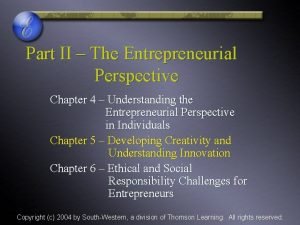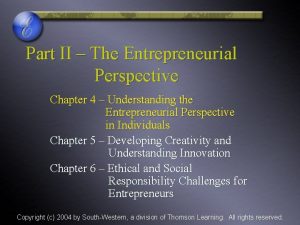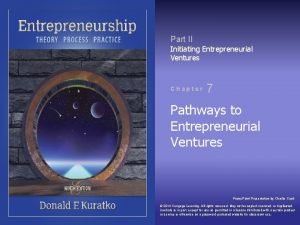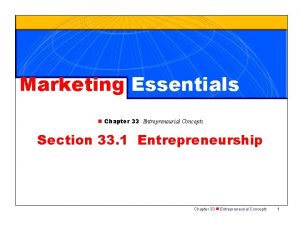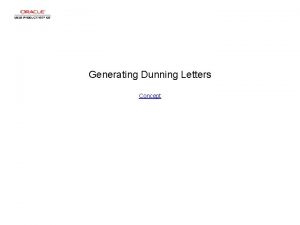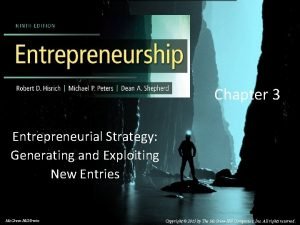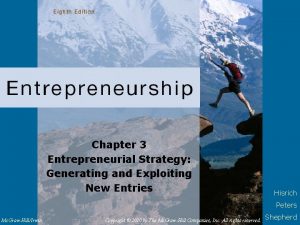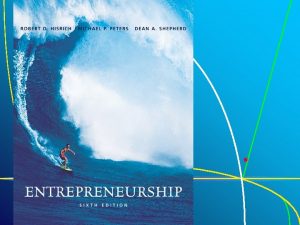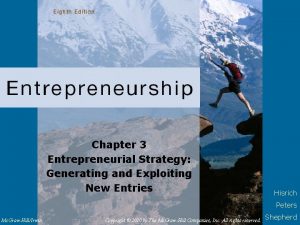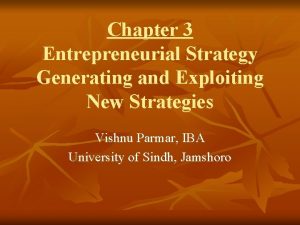Section 1 The Entrepreneurial Perspective Chapter 4 Generating












- Slides: 12

Section 1 The Entrepreneurial Perspective Chapter 4 Generating and Exploiting New Entries ©Mc. Graw-Hill Education. All rights reserved. Authorized only for instructor use in the classroom. No reproduction or further distribution permitted without the prior written consent of Mc. Graw-Hill Education.

New Entry New entry is one of the essential acts of entrepreneurship. • Newness can be both good and bad. Entrepreneurial strategy maximizes benefits of newness and minimizes its costs. Elements include: • The generation of a new entry opportunity. • The exploitation of a new entry opportunity. • A feedback loop. If the new entry is exploited, performance depends on: • Entry strategy. • Risk reduction strategy. • The way the firm is organized. • Competence of the entrepreneur and management team. ©Mc. Graw-Hill Education.

Generation of a New Entry Opportunity Resources are the building blocks, combined in various ways to achieve superior performance. • Valuable if it allows the firm to pursue opportunities, neutralize threats, and offer products and services valued by customers. • Rare when few or no competitors have it. • Inimitable when replicating the bundle is difficult and/or costly. ©Mc. Graw-Hill Education.

Entrepreneurial Resource The basis for entrepreneurial resource is knowledge built up over time through experience – idiosyncratic, therefore rare. • The entrepreneur’s market knowledge is deeper than knowledge gained through market research. • Entrepreneurs who lack this knowledge are less likely to recognize or create attractive opportunities for new products or new markets. • An entrepreneur’s technological knowledge often leads to new markets rather than meeting unmet market needs. A resource bundle is the basis for a new entry – created from the entrepreneur’s market and technological knowledge, and other resources. ©Mc. Graw-Hill Education.

Assessing the Attractiveness of a New Entry Opportunity The following considerations help the entrepreneur determine if the product is valuable, rare, inimitable and worth pursuing. • Information on a new entry. • Window of opportunity may be open or shut. • Comfort in making decisions under uncertainty – must choose between an error of commission or an error of omission. The assessment of a new entry’s attractiveness is less about if the opportunity exists and more about the entrepreneur believing they can make it work with entrepreneurial strategies. ©Mc. Graw-Hill Education.

First Mover Entry Strategy First movers develop a cost advantage First movers face less competitive rivalry. First movers can secure important suppliers and channels of distribution. First movers are better positioned to satisfy customers. ©Mc. Graw-Hill Education. First movers gain expertise through participation. First movers do not always prosper. First mover advantages must outweigh the disadvantages and depend on: • Environmental stability. • Ability to educate customers. • Ability to erect barriers to entry and imitation to extend the firm’s lead time.

Environmental Instability – First Mover (Dis)Advantages Performance depends on the fit between a firm’s bundle of resources and the external environment. • For a good fit, first determine key success factors. • Environmental changes are likely in emerging industries. Entrepreneurs face demand technological uncertainty. • Demand uncertainty makes it difficult to estimate future demand. • First movers must often commit to a new, unproven technology resulting in technological uncertainty. • When demand is unstable or technological uncertainty is high, first mover disadvantages may outweigh first mover advantages. • Changes in demand or technology means the firm must adapt to new environmental conditions – difficult due to inertia. ©Mc. Graw-Hill Education.

Customers’ Uncertainty and First Mover (Dis)Advantages The element of newness may mean uncertainty for customers. • They may be uncertain about how to use the product or its benefits. To reduce this uncertainty, entrepreneurs can: • Offer informational advertising or use comparison marketing. When the product is highly innovative, the customer may lack a frame of reference for processing product information. By delaying entry in a market requiring considerable education, the firm might benefit from the investments of first movers. First movers can have an advantage when : • Education directs customer preferences to the firm’s products, when the firm is seen as a “founder, ” and when the firm can erect barriers to entry and imitation. ©Mc. Graw-Hill Education.

Lead Time and First Mover (Dis)Advantages Entry barriers provide a grace period of limited competition. • This lead time lets the first mover prepare for future competition. The first mover can extend lead time by using barriers to entry. • Building customer loyalties. • Building switching costs. • Protecting product uniqueness. • Securing access to important sources of supply and distribution. Barriers to entry reduce competition. If there is insufficient customer demand, consider allowing competitor into the industry to share pioneering costs. ©Mc. Graw-Hill Education.

Risk Reduction Strategies for New Entry Exploitation A new entry involves considerable risk. The choice of market scope ranges from a narrow- to a broadscope strategy depending on the risk targeted for reduction. • Narrow-scope strategy offers a small product range to a small number of customer groups. • Vulnerable to the risk that market demand does not materialize or changes over time. • A broad-scope strategy takes a “portfolio” approach and offers a range of products. • If new entry involves creation of a new market, a broad-scope strategy reduces the major risk of uncertainty over customer preferences. ©Mc. Graw-Hill Education.

Imitation Strategies Imitation strategy is another strategy for minimizing risk. • Imitation is easier than conducting a systematic and expensive search. • Imitating successful practices helps the entrepreneur develop skills necessary for industry success. • Imitation provides organizational legitimacy. Imitation strategies include franchising and “me-too” strategy. • In the “me-too” strategy, variations may be minor product changes, entering new markets, or delivering the product in a different way. An imitation strategy may reduce R&D costs, reduce customer uncertainty, and provide immediate legitimacy. ©Mc. Graw-Hill Education.

Managing Newness Creation of a new organization offers some liabilities of newness. • Learning new tasks is expensive and takes time. • Role responsibility may overlap or have gaps. • The informal structure takes time to establish. The entrepreneur can also benefit from assets of newness. • Established routines can be a liability when the firm faces change. • Previous practices create momentum, redirection is difficult. A heightened ability to learn new knowledge is a source of competitive advantage. New ventures have strategic advantage over mature companies, particularly in dynamic environments. ©Mc. Graw-Hill Education.
 Invention extension duplication synthesis
Invention extension duplication synthesis The entrepreneurial perspective
The entrepreneurial perspective Two point perspective box
Two point perspective box Silo perspective vs business process perspective
Silo perspective vs business process perspective Pathways to entrepreneurial ventures
Pathways to entrepreneurial ventures Chapter 33 entrepreneurial concepts
Chapter 33 entrepreneurial concepts Section quick check chapter 10 section 1 meiosis answer key
Section quick check chapter 10 section 1 meiosis answer key Hình ảnh bộ gõ cơ thể búng tay
Hình ảnh bộ gõ cơ thể búng tay Bổ thể
Bổ thể Tỉ lệ cơ thể trẻ em
Tỉ lệ cơ thể trẻ em Voi kéo gỗ như thế nào
Voi kéo gỗ như thế nào Chụp tư thế worms-breton
Chụp tư thế worms-breton
